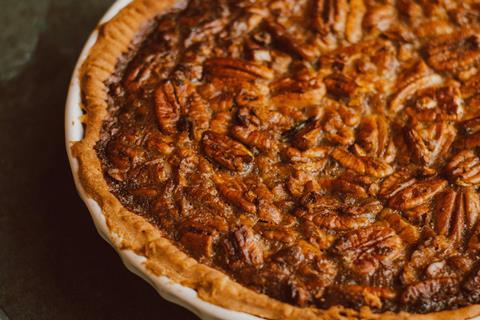Before those sweet and savory pecans make their way into your pecan pie or other holiday treat, they may go through an antimicrobial wash to reduce pathogens. But why would that be needed?

“In‐shell pecans are typically harvested after falling from trees to the ground, which presents a potential route of contamination for foodborne pathogens from soil contact,” said Jennifer Acuff, assistant professor of food microbiology and safety in the food science department for the Arkansas Agricultural Experiment Station, the research arm of the University of Arkansas System Division of Agriculture.
According to the 2024 Arkansas Agriculture Profile, Arkansas ranks eighth in the United States for pecan production, with 9,766 acres of pecan trees reported in 2022. Pecans are harvested from early September through November.
To identify best practices for microbial safety in the pecan market, Acuff conducted a study to evaluate methods of sanitizing pecans against Shiga toxin-producing E. coli, also known as STEC. The study was published in the Journal of Food Protection.
Toxin-producing bacteria
E. coli are a diverse group of bacteria that normally live in the intestines of humans and animals. Although most strains of these bacteria are harmless, some produce toxins like the Shiga toxin that can cause severe gastrointestinal illness and secondary complications, such as kidney failure.
READ MORE: Global food safety: prepare for the unexpected
READ MORE: Unmasking the hidden threat of non-O157 STEC
Acuff advocated for preparedness, emphasizing the proactive approach to food safety for pecan producers. She said while no outbreaks have been associated with pecans, all tree nuts, including pecans, share susceptibility to contamination that could harm the industry. Her goal is to offer food safety solutions preemptively, allowing producers to adopt safety measures early or have them ready when needed.
“Pecans are still one of the larger specialty crops for Arkansas,” Acuff said. “We don’t produce nearly as much in tonnage as Georgia, Texas and New Mexico, but it is a large contributor to our economy. Providing some proactive and sustainable food safety strategies is one way to protect our local pecan growers’ and shellers’ businesses.”
Outside the rules
Although the U.S. Food and Drug Administration’s Food Safety Modernization Act includes preventive controls for human food and a produce safety rule, pecan products often fall outside these rules based on how and where they’re sold, Acuff explained. The rules are advantageous for small growers now, but a single contamination incident could lead to stricter regulations impacting all growers, she said.
Growing and harvesting pecans in open environments provides the potential for cross‐contamination of foodborne pathogens, Acuff noted. Fecal matter from wildlife and livestock serve as the potential contamination sources.
Acuff’s recent study explored whether pre-cleaning pecans before applying sanitizers like lactic acid or chlorine would improve their effectiveness.
Hot water or chemicals
Pecans were directly or soil-inoculated with a variety of STEC strains. Direct inoculation was done by spraying the STEC cocktail on the in-shell pecans. For soil‐inoculation pecans, soil was heat-treated to reduce baseline microbial populations before being sprayed with the STEC cocktail. The STEC-contaminated soil was then used to coat in‐shell pecans.
Inoculated pecans were put through washing treatments for two, five and 10 minutes of either 2 percent lactic acid, 1,000 parts-per-million free chlorine, hot water averaging about 185 degrees Fahrenheit, or ambient water averaging about 64 degrees. After treatments, the spent wash was filtered and analyzed.
A surprising find, Acuff said, was that even when STEC was applied directly to pecans without soil present, the sanitizers still didn’t perform as well as expected, but noted that while the in-shell pecans were visibly clean, there was still organic matter present that may have limited the sanitizer efficacy.
“We suspected hot water was going to be the best method, but I hoped the antimicrobial sanitizers like the lactic acid and chlorine would have done a little more than they showed,” Acuff said.
Hot water wins
The study found the hot water treatment significantly reduced STEC populations from pecans with and without soil, regardless of treatment time, and prevented cross-contamination. While chlorine and lactic acid were not as effective at reducing STEC levels on pecans, they were found to be effective at reducing cross-contamination.
Since lactic acid and chlorine treatments effectively maintained the wash water quality, Acuff said producers could potentially reuse conditioning and wash water by monitoring chemical concentrations to make sure acidity and free chlorine are kept at their target levels.
STEC levels in the chemically treated wash water were generally at or below the detection limit of less than 1 colony forming unit per 100 milliliters.
Acknowledgments
Erin W. Ramsay, a recently graduated food science master’s student, was the first author of the study. Acuff was the corresponding author.
Co-authors included Cameron Bardsley with the U.S. Department of Agriculture’s Agricultural Research Service Tree Nut Research Unit; program associates Karina Desiree and Peter Rubinelli in the food science department; and Samuel Fernandes, assistant professor of agricultural statistics and quantitative genetics with the Division of Agriculture’s Center for Agricultural Data Analytics.
The pecan research was supported by the USDA’s Specialty Crop Block Grant Program administered through the Arkansas Department of Agriculture. The researchers also acknowledged assistance with data collection from University of Arkansas food science students Megan Boothe, Travis Sananikone and Sam Varriale.
Topics
- Agriculture
- Arkansas Agricultural Experiment Station
- Bacteria
- Cameron Bardsley
- chlorine
- crops
- Early Career Research
- Erin W. Ramsay
- Food Security
- hot water
- Infection Prevention & Control
- Jennifer Acuff
- Karina Desiree
- lactic acid
- One Health
- pecans
- Peter Rubinelli
- Research News
- Samuel Fernandes
- Soil & Plant Science
- STEC
- University of Arkansas
- USA & Canada







No comments yet